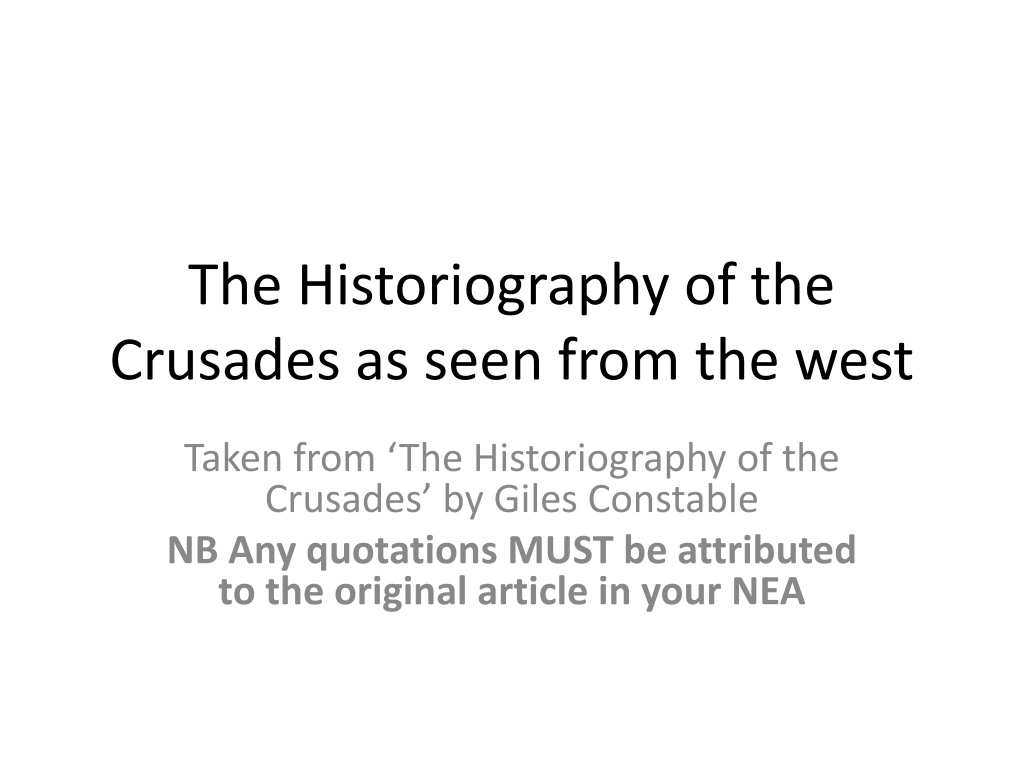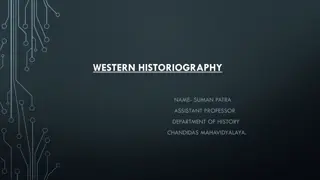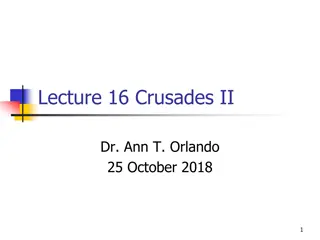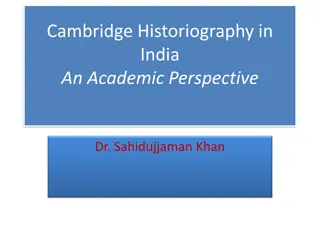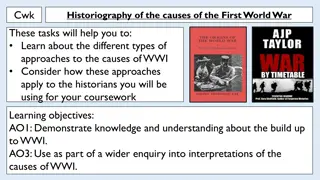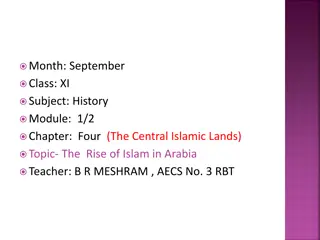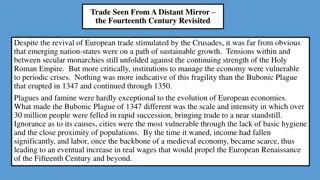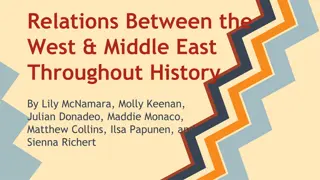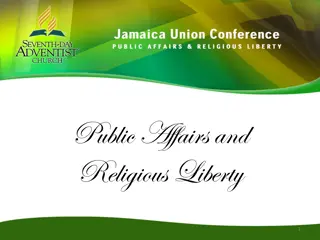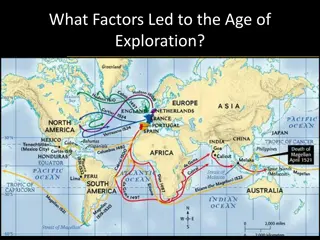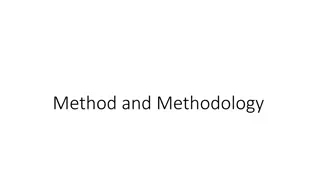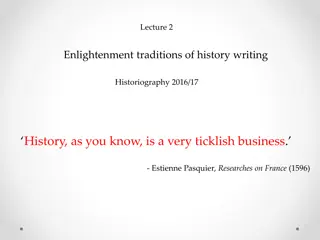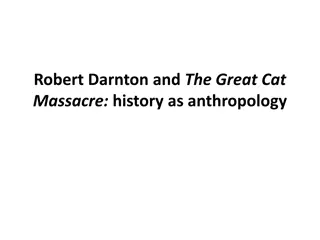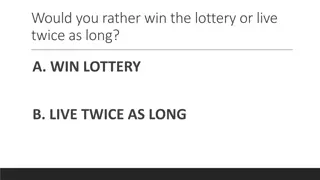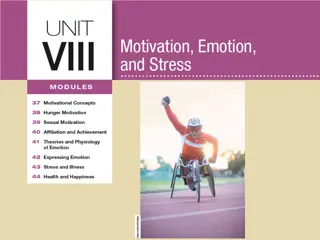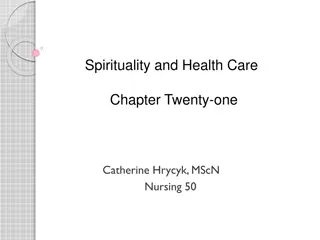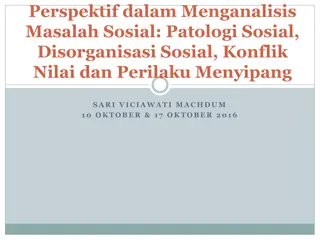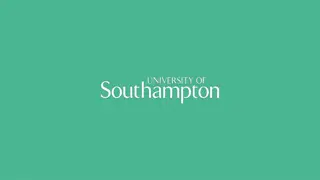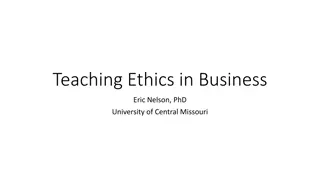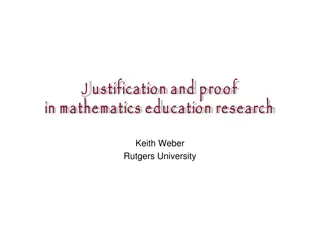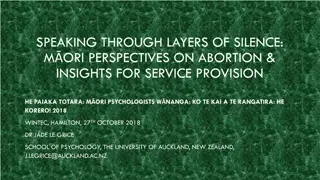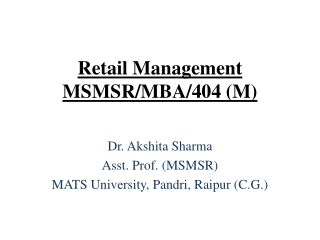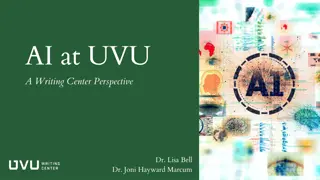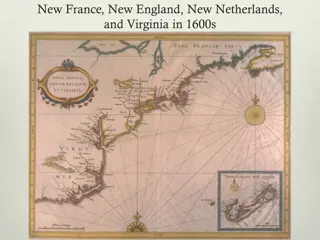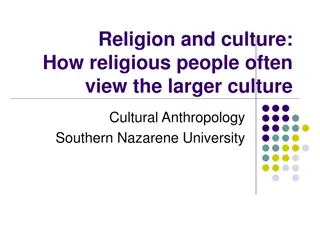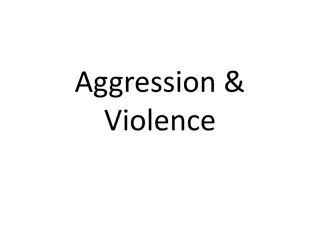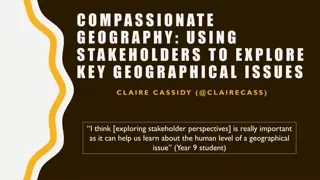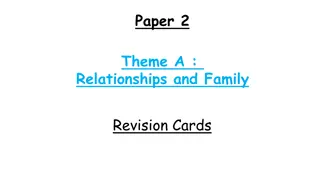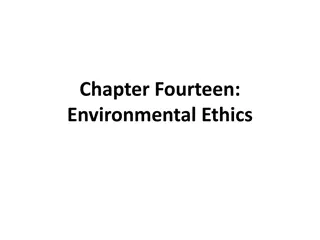Perspectives on the Historiography of the Crusades
The historiography of the Crusades explores diverse viewpoints from western and eastern sources throughout different periods. Various leaders, including Byzantine emperors, Muslim sultans, and indigenous populations, had unique perspectives. The evolving attitudes towards the Crusades reflect changing historical interpretations influenced by political, ideological, and colonial considerations.
Uploaded on Oct 07, 2024 | 0 Views
Download Presentation

Please find below an Image/Link to download the presentation.
The content on the website is provided AS IS for your information and personal use only. It may not be sold, licensed, or shared on other websites without obtaining consent from the author. Download presentation by click this link. If you encounter any issues during the download, it is possible that the publisher has removed the file from their server.
E N D
Presentation Transcript
The Historiography of the Crusades as seen from the west Taken from The Historiography of the Crusades by Giles Constable NB Any quotations MUST be attributed to the original article in your NEA
Many different points of view The crusades were from their inception seen from many different points of view, and every account and reference in the sources must be interpreted in the light of where, when, by whom, and in whose interests it was written
Many different points of view The leaders had their own interests, motives, and objectives, which often put them at odds with one another They were all distrusted by the Byzantine emperor Alexios Komnenos, whose point of view is presented in the Alexiad written by his daughter Anna Komnene The Turkish sultan Kilij Arslan naturally saw things from a different perspective As did the indigenous Christian populations in the east, especially the Armenians, and the peoples of the Muslim principalities of the eastern Mediterranean The rulers of Edessa, Antioch, Aleppo and Damascus, Cairo and Bagdad each had his own attitudes toward the crusades As did the peoples through whose lands the crusaders passed on their way to the east, and in particular the Jews who suffered at t he hands of the followers of Peter the Hermit
Three main periods in terms of the historiography of the Crusades as seen from the west 1.1096 to the end of the C16th 2. C17th and C18th 3. C19th to the present 1.The Muslims were a continuing threat to Western Europe and the defence of Christendom was seen as a pressing concern 2. The crusades moved increasingly into the past, but a past that was coloured by confessional or rational values 3. The crusades were subjected to serious, although not always impartial, scholarly investigation (this period further breaks down into the C19th, when the crusades were generally well regarded, and the C20th, when there has ben a rising tide of criticism and, more recently, a growing division between scholarly and popular views of the crusades
Why the change in attitudes towards the crusades between C19th and C20th? Interest in the crusades today is still influenced by political and ideological interests, including the consequences of European colonialism, the tensions between western and non-western societies, especially in the Middle East, and, more broadly, the legitimacy of using force to promote even worthy and legitimate causes
Evidence of a more critical view in the C20th Steven Runciman: a tragic and destructive episode ; the Holy War itself was nothing more than a long act of intolerance in the name of God, which is the sin against the Holy Ghost (1952-4) Geoffrey Barraclough: We no longer regard the crusades as a great movement in defence of Western Christendom, but rather the manifestation of a new, driving, aggressive spirit We no longer regard the Latin states of Asia Minor as outposts of civilization but rather as radically unstable centres of colonial exploitation (He attributed this change in verdict on the crusades to the experience of total war and the hazards of living in a thermonuclear age) War is always evil, if sometimes an inescapable evil; Holy War is the evil of evils (1970) John Ward: the crusades as a movement of violent white supremacist colonialism (1995) Leaflet circulated in Clermont during the conference held in 1995 to commemorate the summons to the First Crusade called on the Pope to deny that any war can be holy and that sins can be forgiven by killing pagans. According to this view, the crusaders were inspired by greed and religious fanaticism and the Muslims were the innocent victims of expansionist aggression.
And a modern interpretation which links back to contemporary opinions Many scholars today reject this hostile judgement They emphasise the defensive character of the crusades as seen by contemporaries who believed that Christianity was endangered Almost all the contemporary or near contemporary historians and chroniclers considered them a response to Muslim threats to Christian holy places William of Tyre, the most famous crusader historian said his aim was to record for the everlasting memory of the faithful of Christ the way in which God wanted to relieve the long-lasting oppression of his people. The history of the crusades became part of the ongoing propaganda of the crusading movement
Later medieval accounts In these the Crusades were always presented as a response to the external attacks of the Muslims and pagans or to the internal threats of heretics and schismatics Turkish victories in the fifteenth century (Constantinople fell to the Turks in 1453) stimulated new interest in the crusades Some hoped to find in the accounts of previous crusades guidance and inspiration for the contemporary campaigns against the Turks
C16th The crusades tended to move into the past although crusading ideology was kept alive also by the wars of religion with both Catholics and Protestants seeing themselves as soldiers of Christ fighting a Holy War
The second period of crusading historiography 1611 publication of an important collection of primary sources by Jacques Bongars 1639 publication of Thomas Fuller s Historie of the Holy Warre the first serious general history of the crusades to treat them fully in the past and to raise the question of their legitimacy For rationalist writers of the Enlightenment period (e.g. Voltaire) the crusades were inspired by religious zeal, worldly motives, and ecclesiastical interference in secular affairs (Gibbon talked of the crusaders savage fanaticism ; Voltaire called the crusaders adventurers and brigands who were moved by the thirst for brigandage
The third period of crusading historiography A sympathetic attitude to the crusades emerged in the late C18th and early C19th under the influence of romanticism and nationalism (e.g. the novels of Sir Walter Scott) with writers such as Thomas Rowley describing them as a holy war, purifying the Holy Land Publication of two important multi-volume histories of the crusades Friedrich Wilken in Germany and J F Michaud in France. Scholarly interest in the crusades in both France and Germany continued to develop throughout the C19th Scholars in England, Italy and the USA also prepared critical editions of the sources, assessed their value and established the facts of the history of the crusades Two key works published in the C20th were by Rene Grousset (1934-36) and Steven Runciman (1954) both wrote 3 volume histories. Both were basically narrative accounts, but Grousett as an Orientalist and Runciman as a Byzantine scholar both saw the crusades in terms of east-west relations, between either the Christians and Muslims of the Latins and Greeks
The third period of crusading historiography Work in the later C20th paid particular attention to aspects such as the late-medieval crusades, art and architecture , the impact of the crusades in the east, the military orders and especially to the ideology and spirituality of the crusades (the latter a subject of major interest to crusader historians since the publication in 1935 of the German Carl Erdmann s The Origin of the Idea of Crusade (which appeared in English in 1977) More than any other single work written in the twentieth century, Erdmann s book changed the direction of crusading studies ; a number of French historians were working along similar lines although their works were published later
The influence of the work of Erdmann (and others) From their academic studies (which included close and critical study of the sources) they deduced that: Contemporaries mostly had no clear concept of the ideology of crusading There was not even a single generally accepted term for a crusade Throughout the middle ages they were referred to by terms indicating movement or travel e.g. peregrinatio, iter, via, expeditio and, later, passagium and the corresponding verbs, often combined with a reference to Jerusalem, the Holy Land, the Holy Sepulchre or the cross, and in the vernacular with outre mer or uber meer Contemporaries often expressed a religious engagement or desire (negotium, bellum, causa, opus, voluntas or later simply crux) and referred to its sacred character or to God, Christ or Jerusalem Although the early crusaders were sometimes referred to as signed with or bearers of the cross, the cross did not become the mark of crusading, as distinct from pilgrimage, until the late C12th. The earliest know use of crozada is in Spain and south western France in the early thirteenth century but it remained rare and crusade was not common in English before the C18th Participants were normally referred to in the early sources as pilgrims or Christians Those scholars who want a strict definition mostly agree on the importance of taking the cross, making a vow and the granting by the papacy of spiritual and worldly privileges, though whether the promise of forgiveness of sins applied to eternal as well as temporal punishments is uncertain
Traditionalists v Pluralists Historians disagree on the centrality of the objective of a crusade Traditionalists argue that the true crusade must be directed toward the east, either to assist the Christians there or to liberate Jerusalem and the Holy Sepulchre; their logic sees the crusades ending with the fall of the crusader states in the east. They therefore regard any crusade not directed towards the east e.g. those in Spain and northern Europe and those against heretics etc. as not legitimate crusading Pluralists argue that the defining feature of a crusade is papal authorisation; they therefore extend the history of the crusades not only geographically but also chronologically, down to recent times; they find it difficult to fit into their definition the popular crusades which were neither authorised nor supported by the papacy A third group of historians follow a spiritual or psychological definition that emphasises the inner spirit and motives of the crusaders and their leaders and they therefore see the First Crusade as the only true crusade as it was marked by widespread religious enthusiasm and popular response (some differentiate between what they see as two First Crusades one official, led by the princes who responded to the appeal of Urban II, and the other popular, led by Peter the Hermit, whose traditional role as the initiator of the First Crusade has recently found some defenders against the attacks of C19th scholars who asserted the priority of the official crusade
Generalists A fourth group of historians who identify the crusades with holy war and the justification of fighting in defence of the faith They emphasise the concept of the just war a war fought at the order of and with the authority of God According to this view, the essential features of a crusade were to carry out the will of God on earth and thus to win forgiveness for sins, with or without papal approval In practice therefore a crusade could be directed against any perceived enemies of God Riley-Smith provides a broad definition of crusade as a holy war fought against those perceived to be the external or internal foes of Christendom for the recovery of Christian property or in defence of the Church or Christian people carrying with it an expectation of forgiveness of sins for those who participated
The crusades as the beginning of European colonialism and expansion ? This interpretation would have surprised contemporaries Although they would not have denied some selfish aspects (e.g. a search for salvation, a desire to escape unwelcome obligations and to find a new life away from home), the main emphasis was on defence and the recovery of lands that had once been Christian Contemporaries placed greater emphasis on self-sacrifice rather than self-seeking Since their was no clear concept of the crusades, their character changed over time They did become more institutionalised as their various features were defined by the popes and canon lawyers of the C13th Prudence and efficiency rather than enthusiasm became the prerequisites for a crusade There was an increasing stress on organisation, regulations, fiscal arrangements and administrative routines Modern historians tend to see the crusade as an event rather than an institution: Riley-Smith Crusading is coming to have the appearance of a spectrum of enterprises each with its own personality, united by common elements
The numbering of the crusades This differs widely both in the sources and in subsequent histories The numbering lacks consistency; even the numbering of crusades I-IV is dubious as it only counts the general expeditions and not the smaller crusades; and no one assigns a number to the crusades in Spain or N-E Europe, the Children s or other popular crusades etc There was no practice of numbering them in the C12th Some modern scholars identify the crusades simply by date
Motivation Traditionally it was considered that crusaders were motivated by both secular and religious motives, the respective (the respective importance was assessed differently according to the scholars religious beliefs and the standards of their times Another factor was an emotional or psychological element the crusaders felt a fierce loyalty to Christ and a sense of outrage that his patrimony and tomb were held by infidels and could be visited by Christians only on sufferance The view that crusaders were motivated largely by greed and self-interest has to some extent been replaced by an acceptance of their sincerity and idealism: Riley- Smith There can be little doubt that those who took the cross were moved on the whole by idealism Several recent writers however have criticised such views for failing to take into account the psychological, sociological and economic theory; interpretations include the crusades being seen as a means of resolving the tension between the religious ideals and worldly violence of medieval society; and as part of a wealth- maximising strategy both by the church and by individual crusaders (thus reviving the views of Voltaire and Gibbon)
Background and origin Some scholars believe they were the result of a spontaneous outpouring Others stress the extensive prehistory of the crusades The First Crusade has been subject to especially intense scrutiny in this regard
Outremer In the second half of the C20th, crusader historians have been especially interested in the Latin Kingdom and other crusader states There is significant debate over whether or not the Latin states should be regarded as colonies in the modern sense
The turning of the crusades against Christians This raised major questions for contemporaries as well as for later writers: for traditionalists who regard the liberation of Jerusalem and the Holy Land as the essential objective of the crusades but also pluralists, because Innocent III disapproved of the Fourth Crusade
Europe & Islam Some scholars still see the crusades in primarily European terms and of relatively little importance to Islam But in parts of the Islamic World they had a profound influence almost from the start The impact of the crusades in the east inspired the critical views of scholars like Runciman and much of the current hostility to the crusades
Conversion Scholars disagree over the extent to which missionary work and conversion played a part in the crusades The earliest crusading sources express the desire to exalt and expand the Christian faith However conversion appears to have played a comparatively small role in motivating the crusades before the C13th
Conclusion More perhaps than any other phenomenon of European history, the crusades hold up a mirror to how the west sees itself and is seen by others, and as the angle of the mirror changes, so does the view of the crusades
See separate PowerPoint and article for the Muslim view of the Crusades
